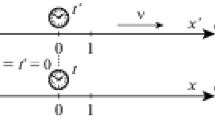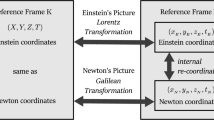Abstract
The relativity of simultaneity is generalized by using the concept of synchronization gauge. The Lorentz transformation is derived without the postulate of the universal limiting speed, and a generalized Edwards transformation is obtained by using the principle of permutation invariance (covariance). It is shown that the existences of the one-way universal limiting speed (in the Lorentz transformation) and the constancy of the two-way average speed of light (in the Edwards transformation) are the necessary consequences of the principle of permutation invariance that is consistent with the postulate of relativity. The connection between the Edward transformation and the general coordinate transformation is discussed, and based on this, we find that the physical meaning of the Edwards parameter, which indicates anisotropy of the speed of light, is a gravitomagnetic potential of the spacetime.
Similar content being viewed by others
References
Jackson, J.D.: Classical Electrodynamics, 3rd edn. Wiley, New York (1998)
Terletskii, Y.P.: Paradoxes in the Theory of Relativity. Plenum, New York (1968)
Lee, A.R., Kalotas, T.M.: Am. J. Phys. 43, 434 (1975)
Mermin, N.D.: Am. J. Phys. 52, 119 (1984)
Coleman, B.: Eur. J. Phys. 24, 301 (2003)
Edwards, W.F.: Am. J. Phys. 31, 482 (1963)
Feinberg, G.: Phys. Rev. 159, 1089 (1967)
Ellis, B., Bowman, P.: Philos. Sci. 34, 116 (1967)
Reichenbach, H.: In: The Philosophy of Space and Time, p. 123. Dover, New York (1958)
Grünbaum, A.: In: Philosophical Problems of Space and Time, 2nd, enlarged edn. Boston Studies in the Philosophy of Science, vol. 12, p. 342. D. Reidel, Dordrecht/Boston (1973)
Winnie, J.: Philos. Sci. 37, 223 (1970)
Zhang, Y.Z.: Experimental Foundations of Special Relativity (in Chinese). Scientific Press, Peking (1979)
Shen, J.Q.: Gen. Relativ. Gravit. 34, 1423 (2002)
Shen, J.Q.: Phys. Rev. D 70, 067501 (2004)
Wang, R., Zheng, Y., Yao, A., Langley, D.: Phys. Lett. A 312, 7 (2003)
Wang, R., Zheng, Y., Yao, A.: Phys. Rev. Lett. 93, 143901 (2004)
Wang, R., Zheng, Y., Yao, A.: Test of the one-way speed of light and the first-order experiment of Special Relativity using phase-conjugate interferometers. ar**v: physics/0609202 (2006) (www.arxiv.org)
Pardy, M.: New paradox in the special theory of relativity generated by the string dynamics. ar**v: physics/0705024 (2007) (www.arxiv.org)
Author information
Authors and Affiliations
Corresponding author
Rights and permissions
About this article
Cite this article
Shen, J.Q. Generalized Edwards Transformation and Principle of Permutation Invariance. Int J Theor Phys 47, 751–764 (2008). https://doi.org/10.1007/s10773-007-9499-7
Received:
Accepted:
Published:
Issue Date:
DOI: https://doi.org/10.1007/s10773-007-9499-7




